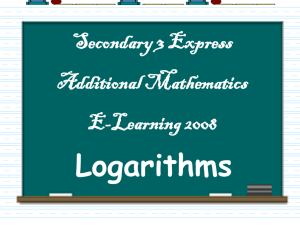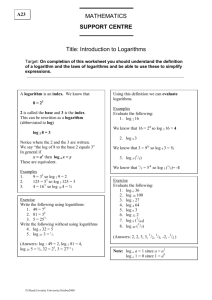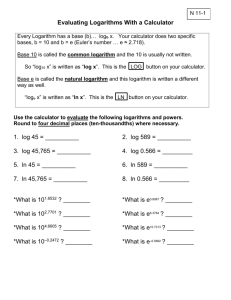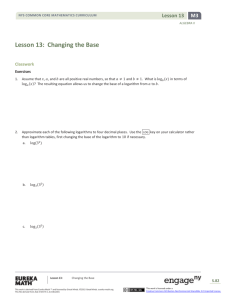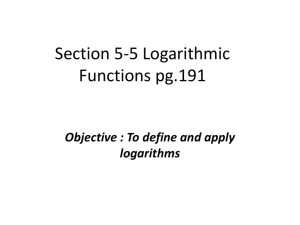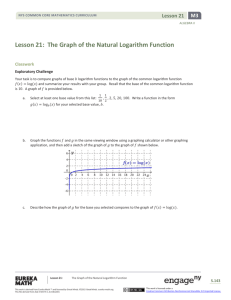Lesson 13: Changing the Base
advertisement
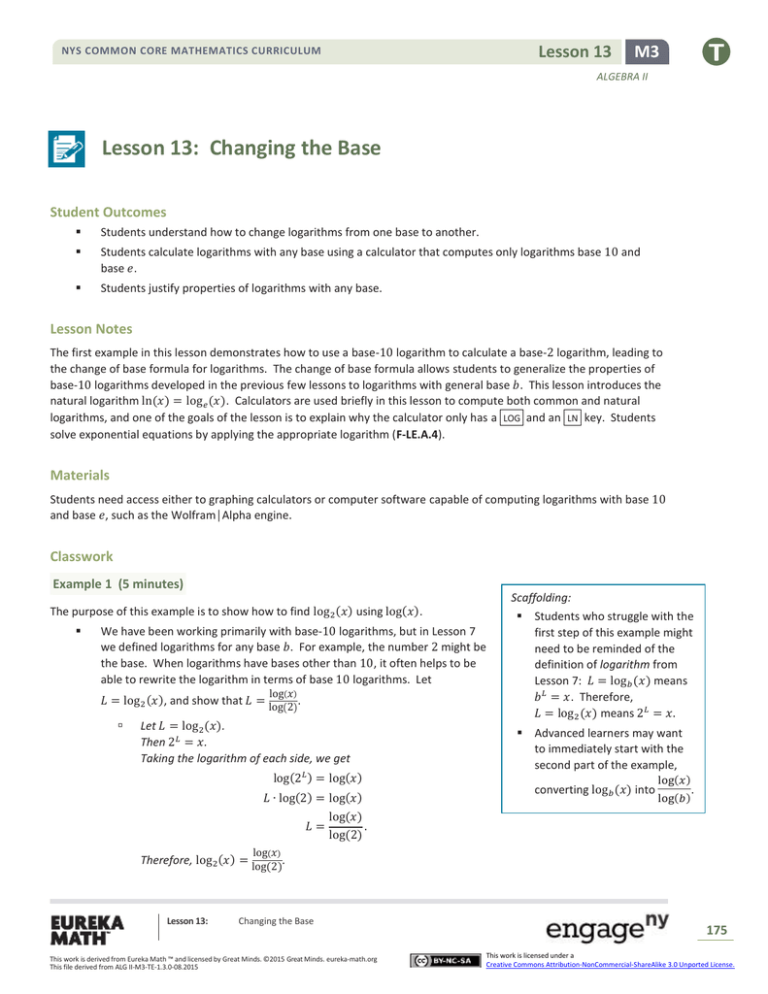
Lesson 13 NYS COMMON CORE MATHEMATICS CURRICULUM M3 ALGEBRA II Lesson 13: Changing the Base Student Outcomes Students understand how to change logarithms from one base to another. Students calculate logarithms with any base using a calculator that computes only logarithms base 10 and base 𝑒. Students justify properties of logarithms with any base. Lesson Notes The first example in this lesson demonstrates how to use a base-10 logarithm to calculate a base-2 logarithm, leading to the change of base formula for logarithms. The change of base formula allows students to generalize the properties of base-10 logarithms developed in the previous few lessons to logarithms with general base 𝑏. This lesson introduces the natural logarithm ln(𝑥) = log 𝑒 (𝑥). Calculators are used briefly in this lesson to compute both common and natural logarithms, and one of the goals of the lesson is to explain why the calculator only has a LOG and an LN key. Students solve exponential equations by applying the appropriate logarithm (F-LE.A.4). Materials Students need access either to graphing calculators or computer software capable of computing logarithms with base 10 and base 𝑒, such as the Wolfram│Alpha engine. Classwork Example 1 (5 minutes) Scaffolding: The purpose of this example is to show how to find log 2 (𝑥) using log(𝑥). We have been working primarily with base-10 logarithms, but in Lesson 7 we defined logarithms for any base 𝑏. For example, the number 2 might be the base. When logarithms have bases other than 10, it often helps to be able to rewrite the logarithm in terms of base 10 logarithms. Let 𝐿 = log 2 (𝑥), and show that 𝐿 = log(𝑥) . log(2) Let 𝐿 = log 2 (𝑥). Then 2𝐿 = 𝑥. Taking the logarithm of each side, we get log(2𝐿 ) = log(𝑥) 𝐿 ∙ log(2) = log(𝑥) 𝐿= Therefore, log 2 (𝑥) = Lesson 13: Students who struggle with the first step of this example might need to be reminded of the definition of logarithm from Lesson 7: 𝐿 = log 𝑏 (𝑥) means 𝑏 𝐿 = 𝑥. Therefore, 𝐿 = log 2 (𝑥) means 2𝐿 = 𝑥. Advanced learners may want to immediately start with the second part of the example, converting log 𝑏 (𝑥) into log(𝑥) log(𝑏) . log(𝑥) . log(2) log(𝑥) . log(2) Changing the Base This work is derived from Eureka Math ™ and licensed by Great Minds. ©2015 Great Minds. eureka-math.org This file derived from ALG II-M3-TE-1.3.0-08.2015 175 This work is licensed under a Creative Commons Attribution-NonCommercial-ShareAlike 3.0 Unported License. Lesson 13 NYS COMMON CORE MATHEMATICS CURRICULUM M3 ALGEBRA II Remember that log(2) is a number, so this shows that log 2 (𝑥) is a rescaling of log(𝑥). The example shows how we can convert log 2 (𝑥) to an expression involving log(𝑥). More generally, suppose we are given a logarithm with base 𝑏. What is log 𝑏 (𝑥) in terms of log(𝑥)? Let 𝐿 = log 𝑏 (𝑥). Then 𝑏 𝐿 = 𝑥. Taking the logarithm of each side, we get log(𝑏 𝐿 ) = log(𝑥) 𝐿 ∙ log(𝑏) = log(𝑥) 𝐿= Therefore, log 𝑏 (𝑥) = log(𝑥) . log(𝑏) log(𝑥) . log(𝑏) This equation not only allows us to change from log 𝑏 (𝑥) to log(𝑥) but to change the base in the other direction as well: log(𝑥) = log 𝑏 (𝑥) ∙ log(𝑏). Exercise 1 (3 minutes) The first exercise deals with the general formula for changing the base of a logarithm. It follows the same pattern as Example 1. Take time for students to share their results from Exercise 1 in a class discussion before moving on to Exercise 2 so that all students understand how the base of a logarithm is changed. Ask students to work in pairs on this exercise. Exercises 1. Scaffolding: If students have difficulty with Exercise 1, they should review the argument in Example 1, noting that it deals with base 10, whereas this exercise generalizes that base to 𝑎. Assume that 𝒙, 𝒂, and 𝒃 are all positive real numbers, so that 𝒂 ≠ 𝟏 and 𝒃 ≠ 𝟏. What is 𝐥𝐨𝐠 𝒃 (𝒙) in terms of 𝐥𝐨𝐠 𝒂(𝒙)? The resulting equation allows us to change the base of a logarithm from 𝒂 to 𝒃. Let 𝑳 = 𝐥𝐨𝐠 𝒃 (𝒙). Then 𝒃𝑳 = 𝒙. Taking the logarithm base 𝒂 of each side, we get 𝐥𝐨𝐠 𝒂 (𝒃𝑳) = 𝐥𝐨𝐠 𝒂 (𝒙) 𝑳 ∙ 𝐥𝐨𝐠 𝒂 (𝒃) = 𝐥𝐨𝐠 𝒂 (𝒙) 𝐥𝐨𝐠 𝒂 (𝒙) 𝑳= . 𝐥𝐨𝐠 𝒂 (𝒃) Therefore, 𝐥𝐨𝐠 𝒃 (𝒙) = 𝐥𝐨𝐠𝒂 (𝒙) . 𝐥𝐨𝐠𝒂 (𝒃) Discussion (2 minutes) Ask a student to present the solution to Exercise 1 to the class to ensure that all students understand how to change the base of a logarithm and how the formula comes from the definition of the logarithm as an exponential equation. Be sure that students record the formula in their notebooks. Change of Base Formula for Logarithms If 𝑥, 𝑎, and 𝑏 are all positive real numbers with 𝑎 ≠ 1 and 𝑏 ≠ 1, then log 𝑎 (𝑥) log 𝑏 (𝑥) = . log 𝑎 (𝑏) Lesson 13: Changing the Base This work is derived from Eureka Math ™ and licensed by Great Minds. ©2015 Great Minds. eureka-math.org This file derived from ALG II-M3-TE-1.3.0-08.2015 176 This work is licensed under a Creative Commons Attribution-NonCommercial-ShareAlike 3.0 Unported License. NYS COMMON CORE MATHEMATICS CURRICULUM Lesson 13 M3 ALGEBRA II Exercise 2 (2 minutes) In the second exercise, students practice changing bases. They need a calculator with the ability to calculate logarithms base 10. Later in the lesson, students need to calculate natural logarithms as well. Students should work in pairs on this exercise, with one student using the calculator and the other keeping track of the computation. Students should share their results for Exercise 2 in a class discussion before moving on to Exercise 3. 2. Approximate each of the following logarithms to four decimal places. Use the LOG key on your calculator rather than logarithm tables, first changing the base of the logarithm to 𝟏𝟎 if necessary. a. 𝐥𝐨𝐠(𝟑𝟐 ) 𝐥𝐨𝐠(𝟑𝟐 ) = 𝐥𝐨𝐠(𝟗) ≈ 𝟎. 𝟗𝟓𝟒𝟐 Therefore, 𝐥𝐨𝐠(𝟑𝟐 ) ≈ 𝟎. 𝟗𝟓𝟒𝟐. Scaffolding: OR 𝐥𝐨𝐠(𝟑𝟐 ) = 𝟐 𝐥𝐨𝐠(𝟑) ≈ 𝟐 ∙ 𝟎. 𝟒𝟕𝟕𝟏 ≈ 𝟎. 𝟗𝟓𝟒𝟐 Therefore, 𝐥𝐨𝐠(𝟑𝟐 ) ≈ 𝟎. 𝟗𝟓𝟒𝟐. b. 𝐥𝐨𝐠 𝟑 (𝟑𝟐 ) 𝐥𝐨𝐠 𝟑 (𝟑𝟐 ) = Students who are not familiar with the LOG key on the calculator can check how it works by evaluating the following expressions: log(1), 𝟐 𝐥𝐨𝐠(𝟑) =𝟐 𝐥𝐨𝐠(𝟑) log(10), Therefore, 𝐥𝐨𝐠 𝟑 (𝟑𝟐 ) = 𝟐. 𝟎𝟎𝟎𝟎. c. log(103 ). 𝐥𝐨𝐠 𝟐 (𝟑𝟐 ) 𝐥𝐨𝐠 𝟐 (𝟑𝟐 ) = 𝐥𝐨𝐠 𝟐 (𝟗) = 𝐥𝐨𝐠(𝟗) ≈ 𝟑. 𝟏𝟔𝟗𝟗 𝐥𝐨𝐠(𝟐) Therefore, 𝐥𝐨𝐠 𝟐 (𝟑𝟐 ) ≈ 𝟑. 𝟏𝟔𝟗𝟗. Exercise 3 (8 minutes) 3. In Lesson 12, we justified a number of properties of base-𝟏𝟎 logarithms. Working in pairs, justify the following properties of base-𝒃 logarithms: a. 𝐥𝐨𝐠 𝒃 (𝟏) = 𝟎 Because 𝑳 = 𝐥𝐨𝐠 𝒃 (𝒙) means 𝒃𝑳 = 𝒙, then when 𝒙 = 𝟏, 𝑳 = 𝟎. b. 𝐥𝐨𝐠 𝒃 (𝒃) = 𝟏 Because 𝑳 = 𝐥𝐨𝐠 𝒃 (𝒙) means 𝒃𝑳 = 𝒙, then when 𝒙 = 𝒃, 𝑳 = 𝟏. c. 𝐥𝐨𝐠 𝒃 (𝐛𝒓 ) = 𝒓 Because 𝑳 = 𝐥𝐨𝐠 𝒃 (𝒙) means 𝒃𝑳 = 𝒙, then when 𝒙 = 𝒃𝒓 , 𝑳 = 𝒓. Lesson 13: Changing the Base This work is derived from Eureka Math ™ and licensed by Great Minds. ©2015 Great Minds. eureka-math.org This file derived from ALG II-M3-TE-1.3.0-08.2015 Scaffolding: By working in pairs, students should be able to reconstruct the arguments they used in Lesson 10. If they have trouble, they should be encouraged to use the definition and properties already justified. 177 This work is licensed under a Creative Commons Attribution-NonCommercial-ShareAlike 3.0 Unported License. Lesson 13 NYS COMMON CORE MATHEMATICS CURRICULUM M3 ALGEBRA II d. 𝒃𝐥𝐨𝐠𝒃(𝒙) = 𝒙 Because 𝑳 = 𝐥𝐨𝐠 𝒃 (𝒙) means 𝒃𝑳 = 𝒙, then 𝒙 = 𝒃𝐥𝐨𝐠 𝒃(𝒙). e. 𝐥𝐨𝐠 𝒃 (𝒙 ∙ 𝒚) = 𝐥𝐨𝐠 𝒃 (𝒙) + 𝐥𝐨𝐠 𝒃 (𝒚) By the rule 𝒂𝒒 ∙ 𝒂𝒓 = 𝒂𝒒+𝒓 , 𝒃𝐥𝐨𝐠 𝒃(𝒙) ∙ 𝒃𝐥𝐨𝐠𝒃(𝒚) = 𝒃𝐥𝐨𝐠 𝒃(𝒙)+𝐥𝐨𝐠𝒃(𝒚) . By property 4, 𝒃𝐥𝐨𝐠 𝒃(𝒙) ∙ 𝒃𝐥𝐨𝐠 𝒃(𝒚) = 𝒙 ∙ 𝒚. Therefore, 𝒙 ∙ 𝒚 = 𝒃𝐥𝐨𝐠𝒃(𝒙)+𝐥𝐨𝐠𝒃(𝒚). By property 4 again, 𝒙 ∙ 𝒚 = 𝒃𝐥𝐨𝐠𝒃(𝒙∙𝒚). So, the exponents must be equal, and 𝐥𝐨𝐠 𝒃 (𝒙 ∙ 𝒚) = 𝐥𝐨𝐠 𝒃 (𝒙) + 𝐥𝐨𝐠 𝒃 (𝒚). f. 𝐥𝐨𝐠 𝒃 (𝒙𝒓 ) = 𝒓 ∙ 𝐥𝐨𝐠 𝒃 (𝒙) 𝒓 By the rule (𝒂𝒒 )𝒓 = 𝒂𝒒𝒓 , 𝒃𝒓 𝐥𝐨𝐠 𝒃(𝒙) = (𝒃𝐥𝐨𝐠𝒃(𝒙) ) . 𝒓 By property 4, (𝒃𝐥𝐨𝐠 𝒃(𝒙) ) = 𝒙𝒓. 𝒓 Therefore, 𝒙𝒓 = 𝒃𝒓𝐥𝐨𝐠𝒃 (𝒙). By property 4 again, 𝒙𝒓 = 𝒃𝐥𝐨𝐠𝒃(𝒙 ) . So, the exponents must be equal, and 𝐥𝐨𝐠 𝒃 (𝒙𝒓 ) = 𝒓 ∙ 𝐥𝐨𝐠 𝒃 (𝒙). g. 𝟏 𝒙 𝐥𝐨𝐠 𝒃 ( ) = −𝐥𝐨𝐠 𝒃 (𝒙) By property 6, 𝐥𝐨𝐠 𝒃 (𝒙𝒌 ) = 𝒌 ∙ 𝐥𝐨𝐠 𝒃 (𝒙). Let 𝒌 = −𝟏; then for 𝒙 ≠ 𝟎, 𝐥𝐨𝐠 𝒃 (𝒙−𝟏 ) = (−𝟏) ∙ 𝐥𝐨𝐠 𝒃 (𝒙). 𝟏 𝒙 Thus, 𝐥𝐨𝐠 𝒃 ( ) = −𝐥𝐨𝐠 𝒃 (𝒙). h. 𝒙 𝒚 𝐥𝐨𝐠 𝒃 ( ) = 𝐥𝐨𝐠 𝒃 (𝒙) − 𝐥𝐨𝐠 𝒃 (𝒚) By property 5, 𝐥𝐨𝐠 𝒃 (𝒙 ∙ 𝒚) = 𝐥𝐨𝐠 𝒃 (𝒙) + 𝐥𝐨𝐠 𝒃 (𝒚). By property 7, for 𝒚 ≠ 𝟎, 𝐥𝐨𝐠 𝒃 (𝒚−𝟏 ) = (−𝟏) ∙ 𝐥𝐨𝐠 𝒃 (𝒚). 𝒙 𝒚 Therefore, 𝐥𝐨𝐠 𝒃 ( ) = 𝐥𝐨𝐠 𝒃 (𝒙) − 𝐥𝐨𝐠 𝒃 (𝒚). Discussion (2 minutes) Define the natural logarithm in this Discussion. Because students often misinterpret the symbol 𝑙𝑛 as the word in, take the time to emphasize that the notation is an L followed by an N, which comes from the French for natural logarithm: le logarithme naturel. Recall Euler’s number 𝑒 from Lesson 5, which is an irrational number approximated by 𝑒 ≈ 2.718 28 …. This number plays an important role in many parts of mathematics, and it is frequently used as the base of logarithms. Because exponential functions with base 𝑒 are used to model growth and change of natural phenomena, a logarithm with base 𝑒 is called a natural logarithm. The notation for the natural logarithm of a positive number 𝑥 is ln(𝑥) = log 𝑒 (𝑥). What is the value of ln(1)? ln(1) = 0 Lesson 13: Changing the Base This work is derived from Eureka Math ™ and licensed by Great Minds. ©2015 Great Minds. eureka-math.org This file derived from ALG II-M3-TE-1.3.0-08.2015 178 This work is licensed under a Creative Commons Attribution-NonCommercial-ShareAlike 3.0 Unported License. Lesson 13 NYS COMMON CORE MATHEMATICS CURRICULUM M3 ALGEBRA II What is the value of ln(𝑒)? The value of ln(𝑒 2 )? Of ln(𝑒 3 )? ln(𝑒) = 1, ln(𝑒 2 ) = 2, and ln(𝑒 3 ) = 3 Because scientists primarily use logarithms base 10 and base 𝑒, calculators often only have two logarithm buttons: LOG for calculating log(𝑥) and LN for calculating ln(𝑥). With the change of base formula, you can use either the common logarithm (base 10) or the natural logarithm (base 𝑒) to calculate the value of a logarithm with any allowable base 𝑏, so technically we only need one of those two buttons. However, each base has important uses, so most calculators are able to calculate logarithms in either base. Exercises 4–6 (5 minutes) Exercises 4–6 allow students to compare the values of ln(𝑥) to the more familiar values of log(𝑥) for a few values of 𝑥 and to conclude that for any 𝑥 ≥ 1, log(𝑥) ≤ ln(𝑥). Students need a calculator with an LN key. They should work in pairs on these exercises, with one student using the calculator and the other recording the result. They should share their results for Exercise 4 in a class discussion before moving on. Scaffolding: 4. Use the LN and LOG keys on your calculator to find the value of each logarithm to four decimal places. a. b. c. d. e. 𝐥𝐧(𝟏) 𝐥𝐧(𝟑) 𝐥𝐧(𝟏𝟎) 𝐥𝐧(𝟐𝟓) 𝐥𝐧(𝟏𝟎𝟎) 𝟎. 𝟎𝟎𝟎𝟎 𝟏. 𝟎𝟗𝟖𝟔 𝟐. 𝟑𝟎𝟐𝟔 𝟑. 𝟐𝟏𝟖𝟗 𝟒. 𝟔𝟎𝟓𝟐 𝐥𝐨𝐠(𝟏) 𝐥𝐨𝐠(𝟑) 𝐥𝐨𝐠(𝟏𝟎) 𝐥𝐨𝐠(𝟐𝟓) 𝐥𝐨𝐠(𝟏𝟎𝟎) 𝟎. 𝟎𝟎𝟎𝟎 𝟎. 𝟒𝟕𝟕𝟏 𝟏. 𝟎𝟎𝟎𝟎 𝟏. 𝟑𝟗𝟕𝟗 𝟐. 𝟎𝟎𝟎𝟎 Students who are not familiar with the LN key on the calculator can check how it works by evaluating the following expressions: ln(1), ln(𝑒), Make a conjecture that compares values of 𝐥𝐨𝐠(𝒙) to 𝐥𝐧(𝒙) for 𝒙 ≥ 𝟏. 5. ln(𝑒 3 ). It appears that for 𝒙 ≥ 𝟏, 𝐥𝐨𝐠(𝒙) ≤ 𝐥𝐧(𝒙). 6. Justify your conjecture in Exercise 5 using the change of base formula. By the change of base formula, 𝐥𝐨𝐠(𝒙) = 𝐥𝐧(𝒙) . Then 𝐥𝐧(𝟏𝟎) ⋅ 𝐥𝐨𝐠(𝒙) = 𝐥𝐧(𝒙). Since 𝐥𝐧(𝟏𝟎) 𝐥𝐧(𝟏𝟎) ≈ 𝟐. 𝟑, 𝐥𝐨𝐠(𝒙) ≤ 𝐥𝐧(𝟏𝟎) ⋅ 𝐥𝐨𝐠(𝒙), and thus 𝐥𝐨𝐠(𝒙) ≤ 𝐥𝐧(𝒙). Example 2 (3 minutes) This example introduces more complicated expressions involving logarithms and showcases the power of logarithms in rearranging logarithmic expressions. Students have done similar exercises in their homework in prior lessons for base10 logarithms, so this example and the following exercises demonstrate how the same procedures apply to natural logarithms. Remind students that Exercise 3 established that the logarithm properties developed for base-10 logarithms apply for logarithms of any base, including base 𝑒. 1 Write as an expression containing only one logarithm: ln(𝑘 2 ) + ln ( 2) − ln(√𝑘). 𝑘 1 1 2 ln(𝑘 2 ) + ln ( 2) − ln(√𝑘) = 2 ln(𝑘) − 2 ln(𝑘) − ∙ ln(𝑘) = − 𝑘 Therefore, ln(𝑘 2) 1 1 ln(𝑘) 2 1 2 + ln ( 2) − ln(√𝑘) = − ln(𝑘). Lesson 13: 𝑘 Changing the Base This work is derived from Eureka Math ™ and licensed by Great Minds. ©2015 Great Minds. eureka-math.org This file derived from ALG II-M3-TE-1.3.0-08.2015 179 This work is licensed under a Creative Commons Attribution-NonCommercial-ShareAlike 3.0 Unported License. Lesson 13 NYS COMMON CORE MATHEMATICS CURRICULUM M3 ALGEBRA II Exercises 7–8 (6 minutes) Exercise 7 follows Example 2 by asking students to simplify more complicated logarithmic expressions. In Exercise 7, students condense a sum of logarithmic expressions to an expression containing only one logarithm, while in Exercise 8, students take a single complicated logarithm and break it up into simpler parts. Students should work in pairs on these exercises, sharing their results in a class discussion before the Closing. 7. Write as a single logarithm. a. 𝟏 𝟑 𝐥𝐧(𝟒) − 𝟑 𝐥𝐧 ( ) + 𝐥𝐧(𝟐) 𝟏 𝐥𝐧(𝟒) − 𝟑 𝐥𝐧 ( ) + 𝐥𝐧(𝟐) = 𝐥𝐧(𝟒) + 𝐥𝐧(𝟑𝟑 ) + 𝐥𝐧(𝟐) 𝟑 = 𝐥𝐧(𝟒 ∙ 𝟑𝟑 ∙ 𝟐) = 𝐥𝐧(𝟐𝟏𝟔) = 𝐥𝐧(𝟔𝟑 ) = 𝟑 𝐥𝐧(𝟔) Any of the last three expressions is an acceptable final answer. b. 𝟑 𝟓 𝐥𝐧(𝟓) + 𝐥𝐧(𝟑𝟐) − 𝐥𝐧(𝟒) 𝟑 𝟑 𝐥𝐧(𝟓) + 𝐥𝐧(𝟑𝟐) − 𝐥𝐧(𝟒) = 𝐥𝐧(𝟓) + 𝐥𝐧 (𝟑𝟐𝟓 ) − 𝐥𝐧(𝟒) 𝟓 = 𝐥𝐧(𝟓) + 𝐥𝐧(𝟖) − 𝐥𝐧(𝟒) = 𝐥𝐧(𝟓 ∙ 𝟖) − 𝐥𝐧(𝟒) 𝟒𝟎 = 𝐥𝐧 ( ) 𝟒 = 𝐥𝐧(𝟏𝟎) 𝟑 𝟓 Therefore, 𝐥𝐧(𝟓) + 𝐥𝐧(𝟑𝟐) − 𝐥𝐧(𝟒) = 𝐥𝐧(𝟏𝟎). 8. Write each expression as a sum or difference of constants and logarithms of simpler terms. a. 𝐥𝐧 ( √𝟓𝒙𝟑 𝒆𝟐 ) √𝟓𝒙𝟑 𝐥𝐧 ( 𝟐 ) = 𝐥𝐧(√𝟓) + 𝐥𝐧 (√𝒙𝟑 ) − 𝐥𝐧(𝒆𝟐 ) 𝒆 𝟏 𝟑 = 𝐥𝐧(𝟓) + 𝐥𝐧(𝒙) − 𝟐 𝟐 𝟐 𝟐 b. (𝒙+𝒚) ) 𝒙𝟐 +𝒚𝟐 𝐥𝐧 ( 𝐥𝐧 ( (𝒙 + 𝒚)𝟐 ) = 𝐥𝐧(𝒙 + 𝒚)𝟐 − 𝐥𝐧(𝒙𝟐 + 𝒚𝟐 ) 𝒙𝟐 + 𝒚𝟐 = 𝟐 𝐥𝐧(𝒙 + 𝒚) − 𝐥𝐧(𝒙𝟐 + 𝒚𝟐 ) The point of this simplification is that neither of these terms can be simplified further. Lesson 13: Changing the Base This work is derived from Eureka Math ™ and licensed by Great Minds. ©2015 Great Minds. eureka-math.org This file derived from ALG II-M3-TE-1.3.0-08.2015 180 This work is licensed under a Creative Commons Attribution-NonCommercial-ShareAlike 3.0 Unported License. Lesson 13 NYS COMMON CORE MATHEMATICS CURRICULUM M3 ALGEBRA II Closing (4 minutes) Have students summarize the lesson by discussing the following questions and coming to a consensus before students record the answers in their notebooks: What is the definition of the logarithm base 𝑏? What does ln(𝑥) represent? If there exist numbers 𝑏, 𝐿, and 𝑥 so that 𝑏 𝐿 = 𝑥, then 𝐿 = log 𝑏 (𝑥). The notation ln(𝑥) represents the logarithm of 𝑥 base 𝑒; that is, ln(𝑥) = log 𝑒 (𝑥). How can we use a calculator to approximate a logarithm to a base other than 10 or 𝑒? Use the change of base formula to convert a logarithm with base 𝑏 to one with base 10 or base 𝑒; then, use the appropriate calculator function. Lesson Summary We have established a formula for changing the base of logarithms from 𝒃 to 𝒂: 𝐥𝐨𝐠 𝒃 (𝒙) = 𝐥𝐨𝐠𝒂 (𝒙) . 𝐥𝐨𝐠𝒂 (𝒃) In particular, the formula allows us to change logarithms base 𝒃 to common or natural logarithms, which are the only two kinds of logarithms that most calculators compute: 𝐥𝐨𝐠 𝐛 (𝒙) = 𝐥𝐨𝐠(𝒙) 𝐥𝐧(𝒙) = . 𝐥𝐨𝐠(𝒃) 𝐥𝐧(𝒃) We have also established the following properties for base 𝒃 logarithms. If 𝒙, 𝒚, 𝒂, and 𝒃 are all positive real numbers with 𝒂 ≠ 𝟏 and 𝒃 ≠ 𝟏 and 𝒓 is any real number, then: 1. 𝐥𝐨𝐠 𝒃 (𝟏) = 𝟎 2. 𝐥𝐨𝐠 𝒃 (𝒃) = 𝟏 3. 𝐥𝐨𝐠 𝒃 (𝒃𝒓 ) = 𝒓 4. 𝒃𝐥𝐨𝐠 𝒃(𝒙) = 𝒙 5. 𝐥𝐨𝐠 𝒃 (𝒙 ∙ 𝒚) = 𝐥𝐨𝐠 𝒃 (𝒙) + 𝐥𝐨𝐠 𝒃 (𝒚) 6. 𝐥𝐨𝐠 𝒃 (𝒙𝒓 ) = 𝒓 ∙ 𝐥𝐨𝐠 𝒃 (𝒙) 7. 𝐥𝐨𝐠 𝒃 ( ) = −𝐥𝐨𝐠 𝒃 (𝒙) 8. 𝐥𝐨𝐠 𝒃 ( ) = 𝐥𝐨𝐠 𝒃 (𝒙) − 𝐥𝐨𝐠 𝒃 (𝒚). 𝟏 𝒙 𝒙 𝒚 Exit Ticket (5 minutes) Lesson 13: Changing the Base This work is derived from Eureka Math ™ and licensed by Great Minds. ©2015 Great Minds. eureka-math.org This file derived from ALG II-M3-TE-1.3.0-08.2015 181 This work is licensed under a Creative Commons Attribution-NonCommercial-ShareAlike 3.0 Unported License. Lesson 13 NYS COMMON CORE MATHEMATICS CURRICULUM M3 ALGEBRA II Name Date Lesson 13: Changing the Base Exit Ticket 1. Are there any properties that hold for base-10 logarithms that would not be valid for the logarithm base 𝑒? Why? Are there any properties that hold for base-10 logarithms that would not be valid for some positive base 𝑏, such that 𝑏 ≠ 1? 2. Write each logarithm as an equivalent expression involving only logarithms base 10. 3. a. log 3 (25) b. log100 (𝑥 2 ) Rewrite each expression as an equivalent expression containing only one logarithm. a. 3 ln(𝑝 + 𝑞) − 2 ln(𝑞) − 7 ln(𝑝) 𝑥 𝑦 b. ln(𝑥𝑦) − ln ( ) Lesson 13: Changing the Base This work is derived from Eureka Math ™ and licensed by Great Minds. ©2015 Great Minds. eureka-math.org This file derived from ALG II-M3-TE-1.3.0-08.2015 182 This work is licensed under a Creative Commons Attribution-NonCommercial-ShareAlike 3.0 Unported License. Lesson 13 NYS COMMON CORE MATHEMATICS CURRICULUM M3 ALGEBRA II Exit Ticket Sample Solutions 1. Are there any properties that hold for base-𝟏𝟎 logarithms that would not be valid for the logarithm base 𝒆? Why? Are there any properties that hold for base-𝟏𝟎 logarithms that would not be valid for some positive base 𝒃, such that 𝒃 ≠ 𝟏? No. Any property that is true for a base-𝟏𝟎 logarithm will be true for a base-𝒆 logarithm. The only difference between a common logarithm and a natural logarithm is a scale change because 𝐥𝐨𝐠(𝒙) = 𝐥𝐧(𝒙) = 𝐥𝐧(𝒙) , and 𝐥𝐧(𝟏𝟎) 𝐥𝐨𝐠(𝒙) . 𝐥𝐨𝐠(𝒆) Since 𝐥𝐨𝐠 𝒃 (𝒙) = 𝐥𝐨𝐠(𝒙) , we would only encounter a problem if 𝐥𝐨𝐠(𝒃) = 𝟎, but this only happens when 𝒃 = 𝟏, and 𝟏 𝐥𝐨𝐠(𝒃) is not a valid base for logarithms. 2. Write each logarithm as an equivalent expression involving only logarithms base 𝟏𝟎. a. 𝐥𝐨𝐠 𝟑 (𝟐𝟓) 𝐥𝐨𝐠 𝟑 (𝟐𝟓) = b. 𝐥𝐨𝐠(𝟐𝟓) 𝐥𝐨𝐠(𝟑) 𝐥𝐨𝐠 𝟏𝟎𝟎 (𝒙𝟐 ) 𝐥𝐨𝐠 𝟏𝟎𝟎 (𝒙𝟐 ) = 𝐥𝐨𝐠(𝒙𝟐 ) 𝐥𝐨𝐠(𝟏𝟎𝟎) 𝟐 𝐥𝐨𝐠(𝒙) 𝟐 = 𝐥𝐨𝐠(𝒙) = 3. Rewrite each expression as an equivalent expression containing only one logarithm. a. 𝟑 𝐥𝐧(𝒑 + 𝒒) − 𝟐 𝐥𝐧(𝒒) − 𝟕 𝐥𝐧(𝒑) 𝟑 𝐥𝐧(𝒑 + 𝒒) − 𝟐 𝐥𝐧(𝒒) − 𝟕 𝐥𝐧(𝒑) = 𝐥𝐧((𝒑 + 𝒒)𝟑 ) − (𝐥𝐧(𝒒𝟐 ) + 𝐥𝐧(𝒑𝟕 )) = 𝐥𝐧((𝒑 + 𝒒)𝟑 ) − 𝐥𝐧(𝒒𝟐 𝒑𝟕 ) (𝒑 + 𝒒)𝟑 = 𝐥𝐧 ( 𝟐 𝟕 ) 𝒒 𝒑 b. 𝒙 𝒚 𝐥𝐧(𝒙𝒚) − 𝐥𝐧 ( ) 𝒙 𝐥𝐧(𝒙𝒚) − 𝐥𝐧 ( ) = 𝐥𝐧(𝒙) + 𝐥𝐧(𝒚) − 𝐥𝐧(𝒙) + 𝐥𝐧(𝒚) 𝒚 = 𝟐 𝐥𝐧(𝒚) = 𝐥𝐧(𝒚𝟐 ) 𝒙 𝒚 Therefore, 𝐥𝐧(𝒙𝒚) − 𝐥𝐧 ( ) is equivalent to both 𝟐 𝐥𝐧(𝒚) and 𝐥𝐧(𝒚𝟐 ). Lesson 13: Changing the Base This work is derived from Eureka Math ™ and licensed by Great Minds. ©2015 Great Minds. eureka-math.org This file derived from ALG II-M3-TE-1.3.0-08.2015 183 This work is licensed under a Creative Commons Attribution-NonCommercial-ShareAlike 3.0 Unported License. NYS COMMON CORE MATHEMATICS CURRICULUM Lesson 13 M3 ALGEBRA II Problem Set Sample Solutions 1. Evaluate each of the following logarithmic expressions, approximating to four decimal places if necessary. Use the LN or LOG key on your calculator rather than a table. a. 𝐥𝐨𝐠 𝟖 (𝟏𝟔) 𝐥𝐨𝐠 𝟖 (𝟏𝟔) = 𝐥𝐨𝐠(𝟏𝟔) 𝐥𝐨𝐠(𝟖) = 𝐥𝐨𝐠(𝟐𝟒 ) 𝐥𝐨𝐠(𝟐𝟑 ) 𝟒 ∙ 𝐥𝐨𝐠(𝟐) 𝟑 ∙ 𝐥𝐨𝐠(𝟐) 𝟒 = 𝟑 = 𝟒 𝟑 Therefore, 𝐥𝐨𝐠 𝟖 (𝟏𝟔) = . b. 𝐥𝐨𝐠 𝟕 (𝟏𝟏) 𝐥𝐨𝐠 𝟕 (𝟏𝟏) = 𝐥𝐨𝐠(𝟏𝟏) 𝐥𝐨𝐠(𝟕) ≈ 𝟏. 𝟐𝟑𝟐𝟑 Therefore, 𝐥𝐨𝐠 𝟕 (𝟏𝟏) ≈ 𝟏. 𝟐𝟑𝟐𝟑. c. 𝐥𝐨𝐠 𝟑 (𝟐) + 𝐥𝐨𝐠 𝟐 (𝟑) 𝐥𝐨𝐠 𝟑 (𝟐) + 𝐥𝐨𝐠 𝟐 (𝟑) = 𝐥𝐨𝐠(𝟐) 𝐥𝐨𝐠(𝟑) + 𝐥𝐨𝐠(𝟑) 𝐥𝐨𝐠(𝟐) ≈ 𝟐. 𝟐𝟏𝟓𝟗 Therefore, 𝐥𝐨𝐠 𝟑 (𝟐) + 𝐥𝐨𝐠 𝟐 (𝟑) ≈ 𝟐. 𝟐𝟏𝟓𝟗. 2. Use logarithmic properties and the fact that 𝐥𝐧(𝟐) ≈ 𝟎. 𝟔𝟗 and 𝐥𝐧(𝟑) ≈ 𝟏. 𝟏𝟎 to approximate the value of each of the following logarithmic expressions. Do not use a calculator. a. 𝐥𝐧(𝒆𝟒 ) 𝐥𝐧(𝒆𝟒 ) = 𝟒 𝐥𝐧(𝒆) =𝟒 Therefore, 𝐥𝐧(𝒆𝟒 ) = 𝟒. b. 𝐥𝐧(𝟔) 𝐥𝐧(𝟔) = 𝐥𝐧(𝟐) + 𝐥𝐧(𝟑) ≈ 𝟎. 𝟔𝟗 + 𝟏. 𝟏𝟎 ≈ 𝟏. 𝟕𝟗 Therefore, 𝐥𝐧(𝟔) ≈ 𝟏. 𝟕𝟗. Lesson 13: Changing the Base This work is derived from Eureka Math ™ and licensed by Great Minds. ©2015 Great Minds. eureka-math.org This file derived from ALG II-M3-TE-1.3.0-08.2015 184 This work is licensed under a Creative Commons Attribution-NonCommercial-ShareAlike 3.0 Unported License. Lesson 13 NYS COMMON CORE MATHEMATICS CURRICULUM M3 ALGEBRA II c. 𝐥𝐧(𝟏𝟎𝟖) 𝐥𝐧(𝟏𝟎𝟖) = 𝐥𝐧(𝟒 ⋅ 𝟐𝟕) = 𝐥𝐧(𝟒) + 𝐥𝐧(𝟐𝟕) ≈ 𝟐 𝐥𝐧(𝟐) + 𝟑 𝐥𝐧(𝟑) ≈ 𝟏. 𝟑𝟖 + 𝟑. 𝟑𝟎 ≈ 𝟒. 𝟔𝟖 Therefore, 𝐥𝐧(𝟏𝟎𝟖) ≈ 𝟒. 𝟔𝟖. d. 𝟖 𝟑 𝐥𝐧 ( ) 𝟖 𝐥𝐧 ( ) = 𝐥𝐧(𝟖) − 𝐥𝐧(𝟑) 𝟑 = 𝐥𝐧(𝟐𝟑 ) − 𝐥𝐧(𝟑) ≈ 𝟑(𝟎. 𝟔𝟗) − 𝟏. 𝟏𝟎 ≈ 𝟎. 𝟗𝟕 𝟖 𝟑 Therefore, 𝐥𝐧 ( ) ≈ 𝟎. 𝟗𝟕. 3. Compare the values of 𝐥𝐨𝐠 𝟏 (𝟏𝟎) and 𝐥𝐨𝐠 𝟗 ( 𝟗 𝟏 ) without using a calculator. 𝟏𝟎 Using the change of base formula, 𝐥𝐨𝐠 𝟗 (𝟏𝟎) 𝟏 𝐥𝐨𝐠 𝟗 ( ) 𝟗 𝐥𝐨𝐠 𝟗 (𝟏𝟎) = −𝟏 = −𝐥𝐨𝐠 𝟗 (𝟏𝟎) 𝟏 = 𝐥𝐨𝐠 𝟗 ( ) . 𝟏𝟎 𝐥𝐨𝐠 𝟏 (𝟏𝟎) = 𝟗 Thus, 𝐥𝐨𝐠 𝟏 (𝟏𝟎) = 𝐥𝐨𝐠 𝟗 ( 𝟗 4. 𝟏 ). 𝟏𝟎 Show that for any positive numbers 𝒂 and 𝒃 with 𝒂 ≠ 𝟏 and 𝒃 ≠ 𝟏, 𝐥𝐨𝐠 𝒂 (𝒃) ∙ 𝐥𝐨𝐠 𝒃 (𝒂) = 𝟏. Using the change of base formula, 𝐥𝐨𝐠 𝒂 (𝐛) = 𝐥𝐨𝐠 𝒃 (𝐛) 𝟏 = . 𝐥𝐨𝐠 𝒃 (𝐚) 𝐥𝐨𝐠 𝒃 (𝐚) Thus, 𝐥𝐨𝐠 𝒂 (𝒃) ∙ 𝐥𝐨𝐠 𝒃 (𝒂) = 5. 𝟏 ∙ 𝐥𝐨𝐠 𝒃 (𝒂) = 𝟏. 𝐥𝐨𝐠𝒃(𝒂) Express 𝒙 in terms of 𝒂, 𝒆, and 𝒚 if 𝐥𝐧(𝒙) − 𝐥𝐧(𝒚) = 𝟐𝒂. 𝐥𝐧(𝒙) − 𝐥𝐧(𝒚) = 𝟐𝒂 𝒙 𝐥𝐧 ( ) = 𝟐𝒂 𝒚 𝒙 = 𝒆𝟐𝒂 𝒚 𝒙 = 𝒚 𝒆𝟐𝒂 Lesson 13: Changing the Base This work is derived from Eureka Math ™ and licensed by Great Minds. ©2015 Great Minds. eureka-math.org This file derived from ALG II-M3-TE-1.3.0-08.2015 185 This work is licensed under a Creative Commons Attribution-NonCommercial-ShareAlike 3.0 Unported License. Lesson 13 NYS COMMON CORE MATHEMATICS CURRICULUM M3 ALGEBRA II 6. Rewrite each expression in an equivalent form that only contains one base-𝟏𝟎 logarithm. a. 𝐥𝐨𝐠 𝟐(𝟖𝟎𝟎) 𝟑 𝐥𝐨𝐠 𝟐 (𝟖𝟎𝟎) = b. 𝐥𝐨𝐠 𝒙 ( 𝐥𝐨𝐠(𝟖𝟎𝟎) 𝐥𝐨𝐠(𝟐 )+𝟐 𝟑 𝐥𝐨𝐠(𝟐)+𝟐 𝟑 𝐥𝐨𝐠(𝟐) 𝟐 𝟐 = = = + = 𝟑+ 𝐥𝐨𝐠(𝟐) 𝐥𝐨𝐠(𝟐) 𝐥𝐨𝐠(𝟐) 𝐥𝐨𝐠(𝟐) 𝐥𝐨𝐠(𝟐) 𝐥𝐨𝐠(𝟐) 𝟏 ), for positive real values of 𝒙 ≠ 𝟏 𝟏𝟎 𝟏 𝐥𝐨𝐠 ( ) 𝟏 𝟏𝟎 = − 𝟏 𝐥𝐨𝐠 𝒙 ( ) = 𝟏𝟎 𝐥𝐨𝐠(𝒙) 𝐥𝐨𝐠(𝒙) c. 𝐥𝐨𝐠 𝟓(𝟏𝟐𝟓𝟎𝟎) 𝟑 𝐥𝐨𝐠 𝟓 (𝟏𝟐𝟓𝟎𝟎) = d. ) 𝟑 = 𝟐 𝐥𝐨𝐠(𝟓 )+𝐥𝐨𝐠(𝟏𝟎 𝐥𝐨𝐠(𝟓) ) = 𝟑 𝐥𝐨𝐠(𝟓)+𝟐 𝐥𝐨𝐠(𝟏𝟎) 𝟐 =𝟑+ 𝐥𝐨𝐠(𝟓) 𝐥𝐨𝐠(𝟓) 𝐥𝐨𝐠 𝟑(𝟎. 𝟖𝟏) 𝐥𝐨𝐠 𝟑 (𝟎. 𝟖𝟏) = 7. 𝟐 𝐥𝐨𝐠(𝟓 ⋅𝟏𝟎 𝐥𝐨𝐠(𝟓) 𝟖𝟏 𝐥𝐨𝐠(𝟏𝟎𝟎 ) 𝐥𝐨𝐠(𝟖𝟏)−𝐥𝐨𝐠(𝟏𝟎𝟎) 𝟒 𝐥𝐨𝐠(𝟑)−𝟐 𝟐 = = =𝟒− 𝐥𝐨𝐠(𝟑) 𝐥𝐨𝐠(𝟑) 𝐥𝐨𝐠(𝟑) 𝐥𝐨𝐠(𝟑) Write each number in terms of natural logarithms, and then use the properties of logarithms to show that it is a rational number. a. 𝐥𝐨𝐠 𝟗(√𝟐𝟕) 𝟑 𝟑 𝟐 𝐥𝐧(√𝟐𝟕) 𝐥𝐧 (𝟑 ) 𝟐 𝐥𝐧(𝟑) 𝟑 = = = 𝐥𝐧(𝟗) 𝐥𝐧(𝟑𝟐 ) 𝟐 𝐥𝐧(𝟑) 𝟒 b. 𝐥𝐨𝐠 𝟖(𝟑𝟐) 𝐥𝐧(𝟑𝟐) 𝐥𝐧(𝟐𝟓 ) 𝟓 = = 𝐥𝐧(𝟖) 𝐥𝐧(𝟐𝟑 ) 𝟑 c. 𝟏 𝟖 𝐥𝐨𝐠 𝟒 ( ) 𝟏 𝐥𝐧 ( ) 𝐥𝐧(𝟐−𝟑 ) 𝟑 𝟖 = =− 𝐥𝐧(𝟒) 𝐥𝐧(𝟐𝟐 ) 𝟐 8. Write each expression as an equivalent expression with a single logarithm. Assume 𝒙, 𝒚, and 𝒛 are positive real numbers. a. 𝐥𝐧(𝒙) + 𝟐 𝐥𝐧(𝒚) − 𝟑 𝐥𝐧(𝒛) 𝒙𝒚𝟐 𝐥𝐧 ( 𝟑 ) 𝒛 Lesson 13: Changing the Base This work is derived from Eureka Math ™ and licensed by Great Minds. ©2015 Great Minds. eureka-math.org This file derived from ALG II-M3-TE-1.3.0-08.2015 186 This work is licensed under a Creative Commons Attribution-NonCommercial-ShareAlike 3.0 Unported License. NYS COMMON CORE MATHEMATICS CURRICULUM Lesson 13 M3 ALGEBRA II b. 𝟏 𝟐 (𝐥𝐧(𝒙 + 𝒚) − 𝐥𝐧(𝐳)) 𝒙+𝒚 𝐥𝐧 (√ ) 𝒛 c. (𝒙 + 𝒚) + 𝐥𝐧(𝒛) (𝒙 + 𝒚) 𝐥𝐧(𝒆) + 𝐥𝐧(𝒛) = 𝐥𝐧(𝒆𝒙+𝒚 ) + 𝐥𝐧(𝒛) = 𝐥𝐧(𝒆𝒙+𝒚 ∙ 𝒛) 9. Rewrite each expression as sums and differences in terms of 𝐥𝐧(𝒙), 𝐥𝐧(𝒚), and 𝐥𝐧(𝒛). a. 𝐥𝐧(𝒙𝒚𝒛𝟑 ) 𝐥𝐧(𝒙) + 𝐥𝐧(𝒚) + 𝟑 𝐥𝐧(𝒛) b. 𝒆𝟑 ) 𝒙𝒚𝒛 𝐥𝐧 ( 𝟑 − 𝐥𝐧(𝒙) − 𝐥𝐧(𝒚) − 𝐥𝐧(𝒛) c. 𝒙 𝒚 𝐥𝐧 (√ ) 𝟏 (𝐥𝐧(𝒙) − 𝐥𝐧(𝒚)) 𝟐 10. Use base-𝟓 logarithms to rewrite each exponential equation as a logarithmic equation, and solve the resulting equation. Use the change of base formula to convert to a base-𝟏𝟎 logarithm that can be evaluated on a calculator. Give each answer to 𝟒 decimal places. If an equation has no solution, explain why. a. 𝟓𝟐𝒙 = 𝟐𝟎 𝟐𝒙 = 𝐥𝐨𝐠 𝟓(𝟐𝟎) 𝟏 𝒙 = 𝐥𝐨𝐠 𝟓(𝟐𝟎) 𝟐 𝐥𝐨𝐠(𝟐𝟎) 𝒙= 𝟐 𝐥𝐨𝐠(𝟓) 𝒙 ≈ 𝟎. 𝟗𝟑𝟎𝟕 b. 𝟕𝟓 = 𝟏𝟎 ∙ 𝟓𝒙−𝟏 𝟕. 𝟓 = 𝟓𝒙−𝟏 𝒙 = 𝐥𝐨𝐠 𝟓(𝟕. 𝟓) + 𝟏 𝒙= 𝐥𝐨𝐠(𝟕. 𝟓) +𝟏 𝐥𝐨𝐠(𝟓) 𝒙 ≈ 𝟐. 𝟐𝟓𝟏𝟗 Lesson 13: Changing the Base This work is derived from Eureka Math ™ and licensed by Great Minds. ©2015 Great Minds. eureka-math.org This file derived from ALG II-M3-TE-1.3.0-08.2015 187 This work is licensed under a Creative Commons Attribution-NonCommercial-ShareAlike 3.0 Unported License. Lesson 13 NYS COMMON CORE MATHEMATICS CURRICULUM M3 ALGEBRA II c. 𝟓𝟐+𝒙 − 𝟓𝒙 = 𝟏𝟎 𝟓𝒙 (𝟓𝟐 − 𝟏) = 𝟏𝟎 𝟏𝟎 𝟓𝒙 = 𝟐𝟒 𝟏𝟎 𝒙 = 𝐥𝐨𝐠 𝟓 ( ) 𝟐𝟒 𝟏𝟎 𝐥𝐨𝐠 ( ) 𝟐𝟒 𝒙= 𝐥𝐨𝐠(𝟓) 𝐥𝐨𝐠(𝟏𝟎) − 𝐥𝐨𝐠(𝟐𝟒) 𝒙= 𝐥𝐨𝐠(𝟓) 𝒙 ≈ −𝟎. 𝟓𝟒𝟒𝟎 d. 𝟐 𝟓𝒙 = 𝟎. 𝟐𝟓 𝒙𝟐 = 𝐥𝐨𝐠 𝟓 (𝟎. 𝟐𝟓) 𝐥𝐨𝐠(𝟎. 𝟐𝟓) 𝒙𝟐 = 𝐥𝐨𝐠(𝟓) 𝒙𝟐 ≈ −𝟎. 𝟖𝟔𝟏𝟒 This equation has no real solution because 𝒙𝟐 cannot be negative for any real number 𝒙. 11. In Lesson 6, you discovered that 𝐥𝐨𝐠(𝒙 ∙ 𝟏𝟎𝒌 ) = 𝒌 + 𝐥𝐨𝐠(𝒙) by looking at a table of logarithms. Use the properties of logarithms to justify this property for an arbitrary base 𝒃 > 𝟎 with 𝒃 ≠ 𝟏. That is, show that 𝐥𝐨𝐠 𝒃 (𝒙 ∙ 𝒃𝒌 ) = 𝒌 + 𝐥𝐨𝐠 𝒃 (𝒙). 𝐥𝐨𝐠 𝒃 (𝒙 ∙ 𝒃𝒌 ) = 𝐥𝐨𝐠 𝒃 (𝒙) + 𝐥𝐨𝐠 𝒃 (𝒃𝒌 ) = 𝒌 + 𝐥𝐨𝐠 𝒃 (𝒙) 12. Larissa argued that since 𝐥𝐨𝐠 𝟐 (𝟐) = 𝟏 and 𝐥𝐨𝐠 𝟐 (𝟒) = 𝟐, then it must be true that 𝐥𝐨𝐠 𝟐 (𝟑) = 𝟏. 𝟓. Is she correct? Explain how you know. MP.3 𝟑 Larissa is not correct. If 𝐥𝐨𝐠 𝟐 (𝒙) = 𝟏. 𝟓, then 𝟐𝟏.𝟓 = 𝒙, so 𝒙 = 𝟐𝟐 = 𝟐√𝟐. Since 𝟑 ≠ 𝟐√𝟐, Larissa’s calculation is not correct. 13. Extension: Suppose that there is some positive number 𝒃 so that 𝐥𝐨𝐠 𝒃 (𝟐) = 𝟎. 𝟑𝟔 𝐥𝐨𝐠 𝒃 (𝟑) = 𝟎. 𝟓𝟕 𝐥𝐨𝐠 𝒃 (𝟓) = 𝟎. 𝟖𝟒. a. Use the given values of 𝐥𝐨𝐠 𝒃 (𝟐), 𝐥𝐨𝐠 𝒃 (𝟑), and 𝐥𝐨𝐠 𝒃 (𝟓) to evaluate the following logarithms. i. 𝐥𝐨𝐠 𝒃 (𝟔) 𝐥𝐨𝐠 𝒃 (𝟔) = 𝐥𝐨𝐠 𝒃(𝟐 ⋅ 𝟑) = 𝐥𝐨𝐠 𝒃(𝟐) + 𝐥𝐨𝐠 𝒃 (𝟑) = 𝟎. 𝟑𝟔 + 𝟎. 𝟓𝟕 = 𝟎. 𝟗𝟑 Lesson 13: Changing the Base This work is derived from Eureka Math ™ and licensed by Great Minds. ©2015 Great Minds. eureka-math.org This file derived from ALG II-M3-TE-1.3.0-08.2015 188 This work is licensed under a Creative Commons Attribution-NonCommercial-ShareAlike 3.0 Unported License. Lesson 13 NYS COMMON CORE MATHEMATICS CURRICULUM M3 ALGEBRA II ii. 𝐥𝐨𝐠 𝒃 (𝟖) 𝐥𝐨𝐠 𝒃 (𝟖) = 𝐥𝐨𝐠 𝒃 (𝟐𝟑 ) = 𝟑 ⋅ 𝐥𝐨𝐠 𝒃 (𝟐) = 𝟑 ⋅ 𝟎. 𝟑𝟔 = 𝟏. 𝟎𝟖 iii. 𝐥𝐨𝐠 𝐛 (𝟏𝟎) 𝐥𝐨𝐠 𝒃 (𝟏𝟎) = 𝐥𝐨𝐠 𝒃(𝟐 ⋅ 𝟓) = 𝐥𝐨𝐠 𝒃 (𝟐) + 𝐥𝐨𝐠 𝒃 (𝟓) = 𝟎. 𝟑𝟔 + 𝟎. 𝟖𝟒 = 𝟏. 𝟐𝟎 iv. 𝐥𝐨𝐠 𝐛 (𝟔𝟎𝟎) 𝐥𝐨𝐠 𝒃 (𝟔𝟎𝟎) = 𝐥𝐨𝐠 𝒃(𝟔 ⋅ 𝟏𝟎𝟎) = 𝐥𝐨𝐠 𝒃 (𝟔) + 𝐥𝐨𝐠 𝒃 (𝟏𝟎𝟎) = 𝟎. 𝟗𝟑 + 𝟐 𝐥𝐨𝐠 𝒃 (𝟏𝟎) = 𝟎. 𝟗𝟑 + 𝟐(𝟏. 𝟐𝟎) = 𝟎. 𝟗𝟑 + 𝟐. 𝟒𝟎 = 𝟑. 𝟑𝟑 b. Use the change of base formula to convert 𝐥𝐨𝐠 𝒃 (𝟏𝟎) to base 𝟏𝟎, and solve for 𝒃. Give your answer to four decimal places. From part (iii) above, 𝐥𝐨𝐠 𝒃 (𝟏𝟎) = 𝟏. 𝟐𝟎. Then, 𝟏. 𝟐𝟎 = 𝐥𝐨𝐠 𝒃 (𝟏𝟎) 𝐥𝐨𝐠 𝟏𝟎 (𝟏𝟎) 𝟏. 𝟐𝟎 = 𝐥𝐨𝐠𝟏𝟎 (𝒃) 𝟏 𝟏. 𝟐𝟎 = 𝐥𝐨𝐠 𝟏𝟎 (𝒃) 𝟏 = 𝐥𝐨𝐠 𝟏𝟎 (𝒃) 𝟏. 𝟐𝟎 𝟏 𝒃 = 𝟏𝟎𝟏.𝟐𝟎 𝒃 ≈ 𝟔. 𝟖𝟏𝟐𝟗. 14. Use a logarithm with an appropriate base to solve the following exponential equations. a. 𝟐𝟑𝒙 = 𝟏𝟔 𝐥𝐨𝐠 𝟐 (𝟐𝟑𝒙 ) = 𝐥𝐨𝐠 𝟐(𝟏𝟔) 𝟑𝒙 = 𝟒 𝟒 𝒙= 𝟑 Lesson 13: Changing the Base This work is derived from Eureka Math ™ and licensed by Great Minds. ©2015 Great Minds. eureka-math.org This file derived from ALG II-M3-TE-1.3.0-08.2015 189 This work is licensed under a Creative Commons Attribution-NonCommercial-ShareAlike 3.0 Unported License. Lesson 13 NYS COMMON CORE MATHEMATICS CURRICULUM M3 ALGEBRA II b. 𝟐𝒙+𝟑 = 𝟒𝟑𝒙 𝐥𝐨𝐠 𝟐 (𝟐𝒙+𝟑 ) = 𝐥𝐨𝐠 𝟐(𝟒𝟑𝒙 ) 𝒙 + 𝟑 = 𝟑𝒙 ⋅ 𝐥𝐨𝐠 𝟐(𝟒) 𝒙 + 𝟑 = 𝟑𝒙 ⋅ 𝟐 𝟓𝒙 = 𝟑 𝟑 𝒙= 𝟓 c. 𝟑𝟒𝒙−𝟐 = 𝟐𝟕𝒙+𝟐 𝐥𝐨𝐠 𝟑 (𝟑𝟒𝒙−𝟐 ) = 𝐥𝐨𝐠 𝟑 (𝟐𝟕𝒙+𝟐 ) (𝟒𝒙 − 𝟐) 𝐥𝐨𝐠 𝟑 (𝟑) = (𝒙 + 𝟐) 𝐥𝐨𝐠 𝟑 (𝟐𝟕) 𝟒𝒙 − 𝟐 = 𝟑(𝒙 + 𝟐) 𝟒𝒙 − 𝟐 = 𝟑𝒙 + 𝟔 𝒙=𝟖 d. 𝟏 𝟒 𝟒𝟐𝒙 = ( ) 𝟑𝒙 𝟏 𝟑𝒙 𝐥𝐨𝐠 𝟒 (𝟒𝟐𝒙 ) = 𝐥𝐨𝐠 𝟒 (( ) ) 𝟒 𝟏 𝟐𝒙 𝐥𝐨𝐠 𝟒 (𝟒) = 𝟑𝒙 𝐥𝐨𝐠 𝟒 ( ) 𝟒 𝟐𝒙 = 𝟑𝒙(−𝟏) 𝟓𝒙 = 𝟎 𝒙=𝟎 e. 𝟓𝟎.𝟐𝒙+𝟑 = 𝟔𝟐𝟓 𝐥𝐨𝐠 𝟓 (𝟓𝟎.𝟐𝒙+𝟑 ) = 𝐥𝐨𝐠 𝟓 (𝟔𝟐𝟓) (𝟎. 𝟐𝒙 + 𝟑)𝐥𝐨𝐠𝟓 (𝟓) = 𝐥𝐨𝐠 𝟓 (𝟓𝟒 ) 𝟎. 𝟐𝒙 + 𝟑 = 𝟒 𝟎. 𝟐𝒙 = 𝟏 𝒙=𝟓 15. Solve each exponential equation. a. 𝟑𝟐𝒙 = 𝟖𝟏 b. 𝒙=𝟐 c. e. 𝒙=𝟐 𝟔𝟐𝟓 = 𝟓𝟑𝒙 𝒙= d. 𝟒 𝟑 𝟑𝟐𝒙−𝟏 = 𝟔𝟑𝒙 = 𝟑𝟔𝒙+𝟏 𝟐𝟓𝟒−𝒙 = 𝟓𝟑𝒙 𝒙= 𝟏 𝟐 f. 𝟒 𝒙= 𝟓 Lesson 13: 𝟖 𝟓 𝟒𝟐𝒙 𝟐𝒙−𝟑 =𝟏 𝒙 = −𝟏 Changing the Base This work is derived from Eureka Math ™ and licensed by Great Minds. ©2015 Great Minds. eureka-math.org This file derived from ALG II-M3-TE-1.3.0-08.2015 190 This work is licensed under a Creative Commons Attribution-NonCommercial-ShareAlike 3.0 Unported License. Lesson 13 NYS COMMON CORE MATHEMATICS CURRICULUM M3 ALGEBRA II g. 𝟏 𝟖𝟐𝒙−𝟒 𝟐𝒙 = 𝟖𝟏 h. =𝟏 𝒙= 𝒙=𝟐 i. 𝟖 = 𝟑𝒙 𝒙= k. 𝟔𝒙+𝟐 = 𝟏𝟐 j. 𝐥𝐧(𝟖) 𝐥𝐧(𝟑) 𝒙 = −𝟐 + 𝟏𝟎𝒙+𝟒 = 𝟐𝟕 𝒙= o. 𝒙= 𝟑𝟐𝒙−𝟑 = 𝟐𝒙+𝟒 𝐥𝐨𝐠(𝟏𝟐) 𝐥𝐨𝐠(𝟔) 𝟐𝒙+𝟏 = 𝟑𝟏−𝒙 l. 𝒙 = −𝟒 + 𝐥𝐨𝐠(𝟐𝟕) m. 𝐥𝐧(𝟖𝟏) 𝐥𝐧(𝟐) 𝐥𝐨𝐠(𝟑) − 𝐥𝐨𝐠(𝟐) 𝐥𝐨𝐠(𝟐) + 𝐥𝐨𝐠(𝟑) 𝒆𝟐𝒙 = 𝟓 n. 𝟒 𝐥𝐨𝐠(𝟐) + 𝟑 𝐥𝐨𝐠(𝟑) 𝟑 𝐥𝐨𝐠(𝟑) − 𝐥𝐨𝐠(𝟐) 𝒙= 𝐥𝐧(𝟓) 𝟐 𝒆𝒙−𝟏 = 𝟔 𝒙 = 𝟏 + 𝐥𝐧(𝟔) 16. In Problem 9(e) of Lesson 12, you solved the equation 𝟑𝒙 = 𝟕−𝟑𝒙+𝟐 using the logarithm base 𝟏𝟎. a. Solve 𝟑𝒙 = 𝟕−𝟑𝒙+𝟐 using the logarithm base 𝟑. 𝐥𝐨𝐠 𝟑 (𝟑𝒙 ) = 𝐥𝐨𝐠 𝟑 (𝟕−𝟑𝒙+𝟐 ) 𝒙 = (−𝟑𝒙 + 𝟐)𝐥𝐨𝐠 𝟑 (𝟕) 𝒙 = −𝟑𝒙 𝐥𝐨𝐠 𝟑 (𝟕) + 𝟐 𝐥𝐨𝐠 𝟑 (𝟕) 𝒙 + 𝟑𝒙 𝐥𝐨𝐠 𝟑 (𝟕) = 𝟐 𝐥𝐨𝐠𝟑 (𝟕) 𝒙(𝟏 + 𝟑 𝐥𝐨𝐠 𝟑 (𝟕)) = 𝟐 𝐥𝐨𝐠𝟑 (𝟕) 𝒙= b. 𝟐 𝐥𝐨𝐠 𝟑 (𝟕) 𝟏 + 𝟑 𝐥𝐨𝐠 𝟑 (𝟕) Apply the change of base formula to show that your answer to part (a) agrees with your answer to Problem 9(e) of Lesson 12. Changing from base 𝟑 to base 𝟏𝟎, we see that 𝐥𝐨𝐠 𝟑 (𝟕) = 𝐥𝐨𝐠(𝟕) . 𝐥𝐨𝐠(𝟑) Then, 𝟐 𝐥𝐨𝐠 𝟑 (𝟕) = 𝟏 + 𝟑 𝐥𝐨𝐠𝟑 (𝟕) = 𝐥𝐨𝐠(𝟕) 𝟐( ) 𝐥𝐨𝐠(𝟑) 𝐥𝐨𝐠(𝟕) 𝟏+ 𝟑( ) 𝐥𝐨𝐠(𝟑) 𝟐 𝐥𝐨𝐠(𝟕) , 𝐥𝐨𝐠(𝟑) + 𝟑 𝐥𝐨𝐠(𝟕) which was the answer from Problem 9(e) of Lesson 12. Lesson 13: Changing the Base This work is derived from Eureka Math ™ and licensed by Great Minds. ©2015 Great Minds. eureka-math.org This file derived from ALG II-M3-TE-1.3.0-08.2015 191 This work is licensed under a Creative Commons Attribution-NonCommercial-ShareAlike 3.0 Unported License. Lesson 13 NYS COMMON CORE MATHEMATICS CURRICULUM M3 ALGEBRA II c. Solve 𝟑𝒙 = 𝟕−𝟑𝒙+𝟐 using the logarithm base 𝟕. 𝐥𝐨𝐠 𝟕 (𝟑𝒙 ) = 𝐥𝐨𝐠 𝟕 (𝟕−𝟑𝒙+𝟐 ) 𝒙 𝐥𝐨𝐠 𝟕 (𝟑) = −𝟑𝒙 + 𝟐 𝟑𝒙 + 𝒙 𝐥𝐨𝐠 𝟕 (𝟑) = 𝟐 𝒙(𝟑 + 𝐥𝐨𝐠 𝟕 (𝟑)) = 𝟐 𝒙= d. 𝟐 𝟑 + 𝐥𝐨𝐠 𝟕 (𝟑) Apply the change of base formula to show that your answer to part (c) also agrees with your answer to Problem 9(e) of Lesson 12. Changing from base 𝟕 to base 𝟏𝟎, we see that 𝐥𝐨𝐠 𝟕 (𝟑) = 𝐥𝐨𝐠(𝟑) . 𝐥𝐨𝐠(𝟕) Then, 𝟐 = 𝟑 + 𝐥𝐨𝐠 𝟕 (𝟑) 𝟐 𝐥𝐨𝐠(𝟑) 𝐥𝐨𝐠(𝟕) 𝟐 𝐥𝐨𝐠(𝟕) = , 𝟑 𝐥𝐨𝐠(𝟕) + 𝐥𝐨𝐠(𝟑) 𝟑+ which was the answer from Problem 9(e) of Lesson 12. 17. Pearl solved the equation 𝟐𝒙 = 𝟏𝟎 as follows: 𝐥𝐨𝐠(𝟐𝒙 ) = 𝐥𝐨𝐠(𝟏𝟎) 𝒙 𝐥𝐨𝐠(𝟐) = 𝟏 𝒙= 𝟏 . 𝐥𝐨𝐠(𝟐) Jess solved the equation 𝟐𝒙 = 𝟏𝟎 as follows: 𝐥𝐨𝐠 𝟐 (𝟐𝒙 ) = 𝐥𝐨𝐠 𝟐 (𝟏𝟎) 𝒙 𝐥𝐨𝐠 𝟐 (𝟐) = 𝐥𝐨𝐠 𝟐 (𝟏𝟎) 𝒙 = 𝐥𝐨𝐠 𝟐 (𝟏𝟎). Is Pearl correct? Is Jess correct? Explain how you know. Both Pearl and Jess are correct. If we take Jess’s solution and apply the change of base formula, we have 𝒙 = 𝐥𝐨𝐠 𝟐 (𝟏𝟎) 𝐥𝐨𝐠(𝟏𝟎) = 𝐥𝐨𝐠(𝟐) 𝟏 = . 𝐥𝐨𝐠(𝟐) MP.3 Thus, the two solutions are equivalent, and both students are correct. Lesson 13: Changing the Base This work is derived from Eureka Math ™ and licensed by Great Minds. ©2015 Great Minds. eureka-math.org This file derived from ALG II-M3-TE-1.3.0-08.2015 192 This work is licensed under a Creative Commons Attribution-NonCommercial-ShareAlike 3.0 Unported License.
